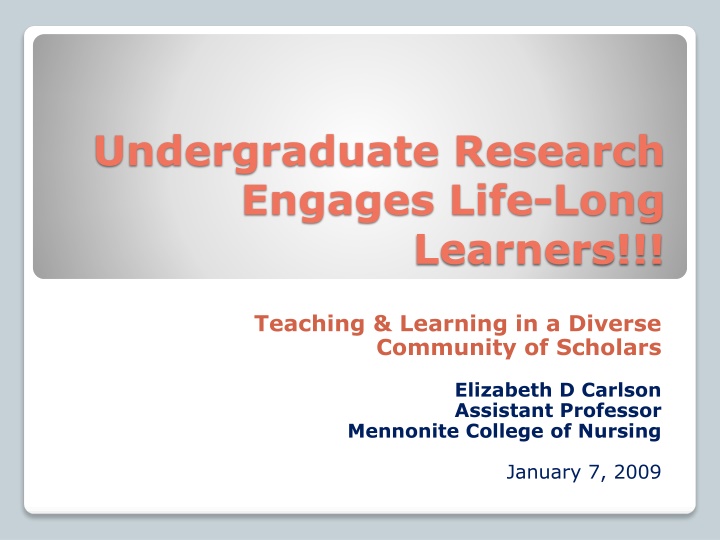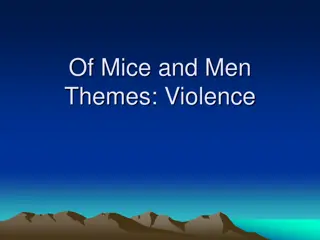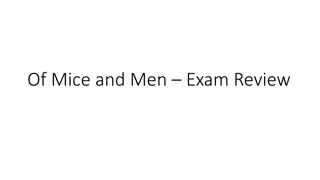
Engaging Undergraduate Learners in Nursing Research and Education
Explore the journey of nursing educators in bridging the gap between knowledge and behavioral change through innovative teaching strategies like journal clubs. Discover how fostering a culture of inquiry and evidence-based practice contributes to transforming nursing education for the better.
Download Presentation

Please find below an Image/Link to download the presentation.
The content on the website is provided AS IS for your information and personal use only. It may not be sold, licensed, or shared on other websites without obtaining consent from the author. If you encounter any issues during the download, it is possible that the publisher has removed the file from their server.
You are allowed to download the files provided on this website for personal or commercial use, subject to the condition that they are used lawfully. All files are the property of their respective owners.
The content on the website is provided AS IS for your information and personal use only. It may not be sold, licensed, or shared on other websites without obtaining consent from the author.
E N D
Presentation Transcript
Undergraduate Research Engages Life-Long Learners!!! Teaching & Learning in a Diverse Community of Scholars Elizabeth D Carlson Assistant Professor Mennonite College of Nursing January 7, 2009
Objectives for today Background and context Successful learning activities Lessons learned Competency outcomes Objectives for Today
Context ISU will position students to excel in a globally competitive, culturally diverse, technological and changing environment by providing students with transformational learning experiences [so that] students recognize their ability to influence social change and must be given the knowledge and skills necessary to do so. Educating Illinois 2008-2014
Context Professional nursing must be grounded in the translation of current evidence into practice. Baccalaureate programs prepare graduates to use skills of inquiry, analysis, and information literacy to address practice issues. Essentials of Baccalaureate Education for Professional Nursing Practice (2008)
Problem As nursing educators and practicing clinicians, we began to understand that the real problem was not content knowledge, but the challenge of shifting attitudes that would result in observable behavioral change. Gap in Knowledge
Journal Clubs to replicate real purpose 1. PICO ? to guide inquiry 2. PICO ? to guide search strategy 3. PICO ? to critically analyze articles 4. PICO ? to synthesize findings 5. PICO ? to evaluate evidence in relation to the question. 6. Reflection via discussion boards Best Evidence-Based Practice in Undergraduate Education
Background Decide on a context for the problem One sentence Identify a gap in their knowledge One sentence Purpose of their inquiry One sentence Journal Clubs as authentic learning places in clinical practice
Context (Background) The rate of labor induction has increased significantly over the past several years. (Gap in Knowledge) While in some cases there are medical reasons for induction of labor, we are interested in the possible complications that arise from elective induction. (Purpose) The purpose of this project is to identify potential complications of elective induction and to ultimately apply this knowledge to clinical practice. Example
Research Question P = population or patient (the who) I = intervention (the what) C = contrasting intervention (optional) O = outcome (morbidity, mortality, quality of life) PICO ? to guide inquiry
Research Question P In expectant mothers, I does elective induction of labor C versus spontaneous labor O carry more risk of physiological morbidity to mother or infant? In expectant mothers, does elective induction of labor versus spontaneous labor carry more risk of physiological morbidity to mother or infant? Example
Search Strategy Librarian assistance Using at least 4 databases Using key terms taken from the PICO question and/or mesh headings Inclusion and Exclusion criteria Results of search PICO question to guide search strategy
Search Strategy Upon consultation with a librarian, the CINAHL database was searched using the heading labor, induced (exploded to include subheadings fetal membranes and artificial rupture) AND the keyword elective . The PUBMED database was searched using the MeSH heading labor, induced AND the key word elective. The Cochrane Database of Systematic Reviews, the Database of Abstracts of Reviews of Effectiveness (DARE), and the National Guideline Clearinghouse were also searched using the terms induced labor , labor, induced , and elective induction and no articles were found to meet our inclusion criteria. Articles were included if they focused on outcomes of elective induction for uncomplicated full-term pregnancies. Articles stated to be commentaries and expert opinion were excluded, as were articles that focused on physician effect of induction outcomes and mothers expecting multiples. This criteria resulted in 8 unduplicated articles. Example
Critical Analysis (to take apart) Citation Type of article Synthesis Level of Evidence RCT Background (2 sentences) Quasi-experimental Purpose (1 sentence) Guidelines or Qualitative PICO question to critically analyze research reports
Critical Analysis (to take apart) Methodology Design Setting Population Sample Independent variable Tools to measure Outcome variable Key findings (< 3) Clinical Meaningfulness (1) Synthesis RCT Quasi-experimental Guidelines or Qualitative PICO question to critically analyze research reports
Clinical Meaningfulness (synthesis) What is the answer to the research question? In expectant mothers, does elective induction of labor versus spontaneous labor carry more risk of physiological morbidity to mother or infant? *Very difficult for students to do without significant coaching. PICO question to synthesize findings
Clinical Meaningfulness (evaluate) The incident rate of uterine rupture to be 9.8 per 1000 vaginal births after cesarean sections (VBAC). The highest risk of uterine rupture occurred in nulliparous women and in women who had VBAC deliveries induced and augmented sequentially with prostaglandin and Pitocin. Level I, II, and III studies consistently reported that women receive inaccurate risk/benefit information necessary to facilitate informed decision. PICO question to evaluate evidence in relation to the question.
Search strategy If I had to choose the ONE thing that I felt was most important about this class, it s that we know so much more about how to pick good and credible articles. We learned (the hard way) that not all articles are created equal and, for me, this was the most important lesson to have learned. Lessons Learned
Levels of Evidence I have learned that there is more to researching a topic than just going out there, grabbing any article I think applies and running with the information they provide I really wish that this method of research was introduced to us before our last semester in nursing school, like in junior high. Lessons Learned
Critical appraisals Being able to attempt multiple critical appraisals on a variety of research articles in almost a trial and error fashion was probably one of the better teaching strategies. I have learned a lot by working to solve problems and taking the time to think, rather than simply memorize. Lessons Learned
Critical Reflection For the first time I have realized that reflection taking time to sit back and think about what we have actually learned and achieved in this class is very important and most of the time we miss out on this important thing in life. Lessons Learned
18 17 16 14 12 12 10 8 6 5 4 3 2 2 0 100 90-99 80-89 70-79 60-69 Final (N=38) Competency Outcomes









